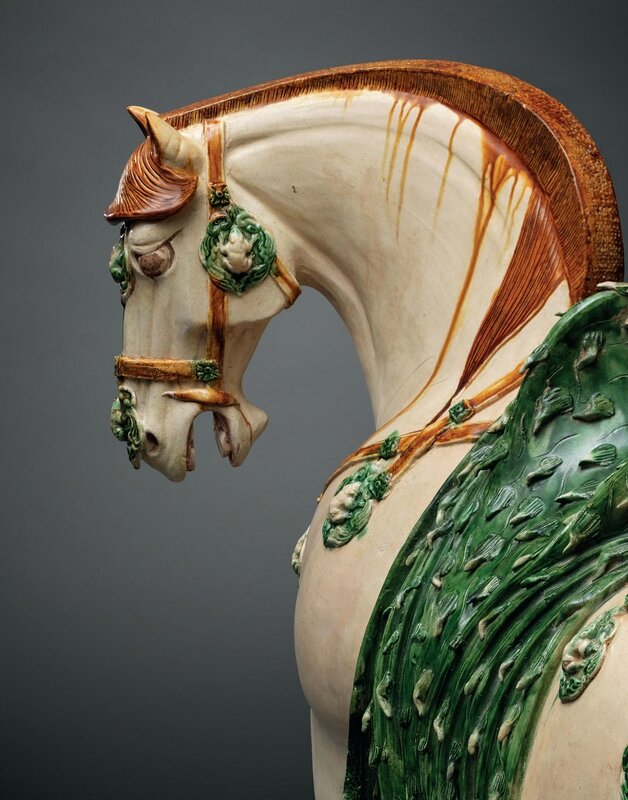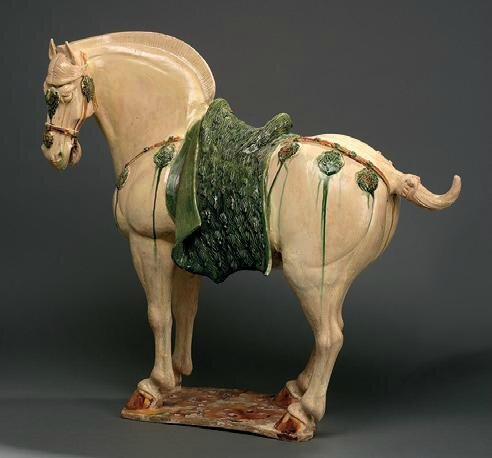A large sancai-glazed figure of a caparisoned horse, Tang dynasty (618-907)
Lot 3106. A large sancai-glazed figure of a caparisoned horse, Tang dynasty (618-907). Estimate HK$6,000,000 – HK$8,000,000 ($776,022 - $1,034,696). Photo Christie's Image Ltd 2016.
The cream-glazed horse is naturalistically modelled standing on a rectangular base, with the mane, tail and hooves highlighted in amber glaze. The head is gracefully curved to the left, with a green textured saddle blanket and foliate-shaped plaques detailed with moulded toads suspending from the trappings. 27 in. (68.5 cm.) high
Provenance: An English private collection, acquired in Hong Kong in the 1980s
Notes: The present sancai horse is exceptionally well-modelled, revealing the technical accomplishment and stylistic maturity of Chinese ceramic sculpture at the peak of the Tang dynasty. This breed of magnificent horses was imported from Ferghana, Central Asia and was immortalised in Chinese literature and the visual arts. The horse itself was a potent image during the vigorous expansion of the Tang ‘golden age’. In style and subject matter, the present horse withsancai or ‘three-colour’ glaze was developed during the sixth century when Tang artisans experimented with sancaiglazes, creating a lively spectrum of blue, green, amber, and yellow over a creamy-white ground. The distribution of glaze on this current horse displays an unusually high degree of control.
Sancai horses of such imposing size are extremely rare and the most prized among collectors. Elaborately caparisoned and standing foursquare with its head gracefully turned to the left, bulging eyes, mouth agape and ears alert, the sculpture successfully imparts a sense of realism and subtle movement. A comparable horse also naturalistically modelled with its head elegantly turned and mouth agape was sold at Christie’s New York, 21 March 2002, lot 103. Another example of similar size is in the Tokyo National Museum, illustrated in Mayuyama, Seventy Years, vol. 1, Tokyo, 1976, no. 198.
The present horse is further distinguished by its detailed animal-form trappings and simulated fur blanket, which adds a refined finish to the beautiful, cream-glazed body. The moulded trappings hang pendent leaf-form plaques enclosing a recumbent toad. Whilst the motif of the toad is rarely seen on appliqués, the importance of the toad can be found in Daoist philosophies dating to the Western Jin dynasty (265-317). It is recorded in the Tong Xuan Jing written by the Daoist philosopher Wang Cheng Wen (230-302), that a toad-like talisman offers protection from evil and harm during battle. The depiction of the toad on trappings appears on several examples of important sancai horses, such as one found in the Idemitsu Museum of Art, Tokyo, illustrated in Chinese Ceramics in the Idemitsu Collection, Tokyo, 1987, no. 50. Another comparable example with similar trappings can be found on a sancai horse in the Palace Museum, Beijing (fig. 1); and another sold at Christie’s New York, 24 March 2004, lot 139.
fig. 1 A sancai-glazed horse. With permission of the Royal Ontario Museum ©ROM

/https%3A%2F%2Fprofilepics.canalblog.com%2Fprofilepics%2F1%2F0%2F100183.jpg)
/https%3A%2F%2Fstorage.canalblog.com%2F03%2F02%2F119589%2F96711876_o.jpg)
/https%3A%2F%2Fstorage.canalblog.com%2F11%2F31%2F119589%2F94773502_o.jpg)
/https%3A%2F%2Fstorage.canalblog.com%2F20%2F83%2F119589%2F94772815_o.jpg)
/https%3A%2F%2Fstorage.canalblog.com%2F26%2F72%2F119589%2F75604929_o.jpg)
/https%3A%2F%2Fstorage.canalblog.com%2F59%2F60%2F119589%2F26458628_o.jpg)





/image%2F1371349%2F20240309%2Fob_b308fe_getcollectionimage.jpg)
/image%2F1371349%2F20240304%2Fob_91d722_telechargement-14.jpg)
/http%3A%2F%2Fstorage.canalblog.com%2F85%2F43%2F119589%2F129846067_o.jpg)
/http%3A%2F%2Fstorage.canalblog.com%2F15%2F52%2F119589%2F129772147_o.jpg)